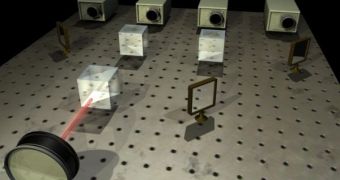A new business partnership between Siemens IT Solutions and Services, in the Netherlands, and id Quantique, from Geneva, Switzerland, promises to bring the goal of accessible quantum cryptography one step closer to general use by the masses, officials from the two companies have announced recently, according to Technology Review. In this communication method, light particles called photons are used to scramble transmission data, in a way that requires vast amounts of computer power and a lot of time to break and decipher.
In spite of the fact that the new technology has been available worldwide for a few years now, only a select few have thus far been able to afford it. We are talking here about governments and large corporations, which are the only entities with sufficient money to design and construct the point-to-point optical cable networks that quantum cryptography requires to work. The new partnership is designed to provide even individuals and small companies with state-of-the-art security for their data, in a new package that includes the devices and cables needed.
Explaining the principles on which this type of technology works is fairly complicated. Data is encoded using photons, the elementary particles that make up light. They are coded with a key that the two parties using the system know and share. The simple act of trying to break into the communication channel has immediate repercussions. As soon as the photons are observed, they immediately change their properties, which is a principle derived from quantum physics. The change and the attack, implicitly, are immediately detected, and so the interception attempt fails.
Until now, available systems have relied on fiber optics cables to function, but now the two companies plan to devise a system that allows for quantum cryptography to take place between two terminals connected with usual cables. Over the past few years, telephone companies have been installing cables called dark fibers into the ground, which do not serve any purpose. They were buried in anticipation of a moment when the technology would exist to use them. “For quantum key distribution, this is a godsend. There is all this dark fiber in the ground right now that's not being used,” the Head of Toshiba Research Europe's Quantum Information Group, Andrew Shields, from the UK, says.
“It's important from a commercial point of view that companies like Siemens, a global player, are showing an interest in this technology. There's potential to really accelerate commercial development,” id Quantique CEO and Co-founder Gregoire Ribordy adds. Plans for the future include using standard wires for the quantum signals, but that seems unlikely to happen very soon. These special signals are very weak – which is why they need separate fiber optics cables in the first place – and average telephone signals are too strong. The quantum ones would most likely get “drowned.”

 14 DAY TRIAL //
14 DAY TRIAL //